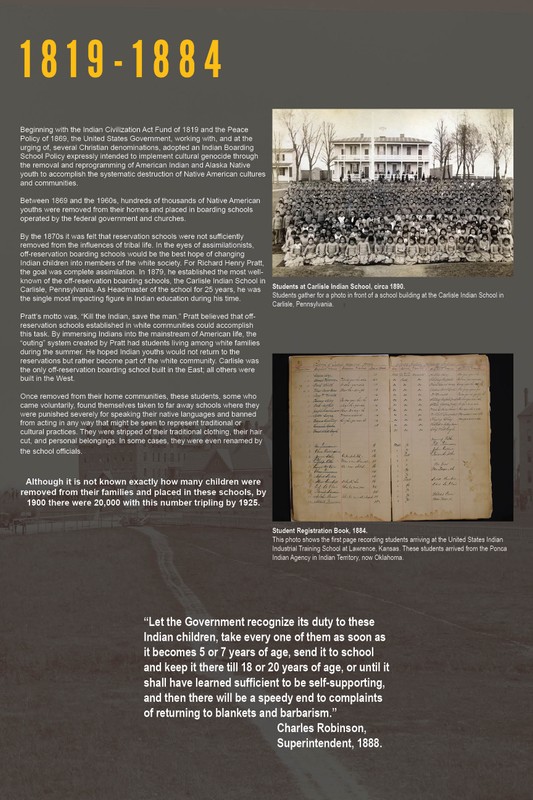1819-1884
Introduction
Text-to-speech Audio
Starting in 1819, the United States Government, working with, and at the urging of, several Christian denominations, adopted an Indian Boarding School Policy expressly intended to implement cultural genocide through the removal and reprogramming of American Indian and Alaska Native youth to accomplish the systematic destruction of Native American cultures and communities.
Images

Backstory and Context
Text-to-speech Audio
Beginning with the Indian Civilization Act Fund of 1819 and the Peace Policy of 1869, the United States Government, working with, and at the urging of, several Christian denominations, adopted an Indian Boarding School Policy expressly intended to implement cultural genocide through the removal and reprogramming of American Indian and Alaska Native youth to accomplish the systematic destruction of Native American cultures and communities.
Between 1869 and the 1960s, hundreds of thousands of Native American youths were removed from their homes and placed in boarding schools operated by the federal government and churches.
By the 1870s it was felt that reservation schools were not sufficiently removed from the influences of tribal life. In the eyes of assimilationists, off-reservation boarding schools would be the best hope of changing Indian children into members of the white society. For Richard Henry Pratt, the goal was complete assimilation. In 1879, he established the most well-known of the off-reservation boarding schools, the Carlisle Indian School in Carlisle, Pennsylvania. As Headmaster of the school for 25 years, he was the single most impacting figure in Indian education during his time.
Pratt’s motto was, “Kill the Indian, save the man.” Pratt believed that off-reservation schools established in white communities could accomplish this task. By immersing Indians into the mainstream of American life, the “outing” system created by Pratt had students living among white families during the summer. He hoped Indian youths would not return to the reservations but rather become part of the white community. Carlisle was the only off-reservation boarding school built in the East; all others were built in the West.
Once removed from their home communities, these students, some who came voluntarily, found themselves taken to far away schools where they were punished severely for speaking their native languages and banned from acting in any way that might be seen to represent traditional or cultural practices. They were stripped of their traditional clothing, their hair cut, and personal belongings. In some cases, they were even renamed by the school officials.
Although it is not known exactly how many children were removed from their families and placed in these schools, by 1900 there were 20,000 with this number tripling by 1925.
Cite This Entry
Campbell, Travis. "1819-1884." Clio: Your Guide to History. November 1, 2023. Accessed April 3, 2025. https://theclio.com/entry/174134

